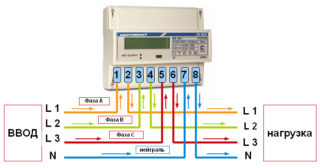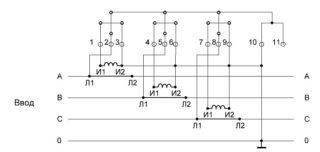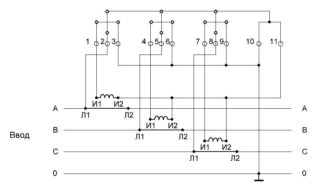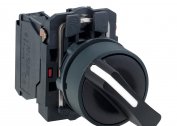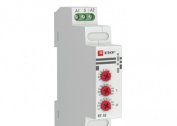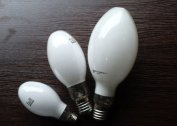When installing electricity meters in private houses, depending on the amount of current in the electric circuit, a very specific connection scheme for a three-phase meter is used. It is connected directly to the supply line break or through a step-down current transformer. The second option for connecting a three-phase electric meter is used for consumption currents of more than 100 amperes. Both of these methods of connecting the meter have their own characteristics, which the owner of the house must understand.
Types of inclusions and their features
Depending on the method of switching the windings of current transformers, three-phase meters installed in electric networks are connected according to the following schemes:
- direct connection;
- indirect inclusion;
- semi-indirect connection.
Direct is called direct inclusion, and to understand the differences between the second and third types, it is necessary to take into account the scope of their application. A purely indirect connection is the open installation of current transformers (CTs) on high-voltage power cables of a three-phase line (6-10 kV). This method is found only in power substations and in large industrial enterprises with their own distribution networks. In domestic conditions, this type of transformer connection is not applicable.
Varieties of the semi-indirect method
There are several schemes for connecting meters based on the semi-indirect method, but the most common are the following:
- ten-wire circuit;
- connection by disconnection on a special block;
- star connection.
Ten-wire switching
Connecting a 3-phase meter using a 10-wire circuit is the easiest and most reliable way. To implement it, you will need to follow the procedure for connecting ten wires: three for each phase and one neutral. This option has one indisputable advantage, consisting in the ability to replace the meter when the power is on. The line may be left energized when repairing a device disconnected from it. With this scheme, the current circuits are reliably grounded, therefore, the possibility of the appearance of a dangerous potential on them is excluded.
Another advantage of a 10-wire connection is the independent connection of each of the three phases. If one of them disappears, the remaining two retain the functionality of the device.
Other wiring diagrams
Connection by means of contact distributors belongs to more complex methods, implemented by switching each of the wires coming from the current transformer. The star connection is also characterized by its complexity, but in this case fewer conductors are used. When mounting the converter, first the unipolar outputs of all three secondary windings are assembled into one common point. After that, the three mating ends of the CT windings are connected to the corresponding terminals of the counter.
Another semi-indirect switching scheme is known, called 7-wire. When it is organized, one of the ends of the windings is connected by jumpers directly in the current transformer. This option is used very rarely in private homes, due to a number of drawbacks of the inclusion scheme.
The choice of meter
Before connecting a 3-phase meter suitable for a private house, you need to make sure that the use of this brand of device is provided for by the type of mains supply.Next, you need to find out what operating current the purchased meter should be designed for. In this case, one should proceed from the value taken into account by the device and the power consumed in the load. As a rule, in this case they are guided by the face value of the input machine, according to which the following options are possible:
- when using a switch with a setting of "40", the operating current of the meter should be 60 Amps;
- at a machine rating of 40-60 Amps, an accounting device with a current limit of 100 Amp should be purchased.
When choosing the right meter for a private house, it is important to think about the possibility of saving electricity consumed in the household. Therefore, preference is usually given to modern electronic devices that have the function of "day-night" and allows you to take into account the cost at a reduced rate.
A big plus of a three-phase meter is the presence in it of the ability to fix the load schedule and keep track of power consumption for any time period. When choosing such a device, it is important to inquire about its accuracy class (from 0.2 to 2.5) and the permissible temperature range. It is advisable that the latter indicator be as wide as possible (from - 20º C to 50º C).
Single phase connection
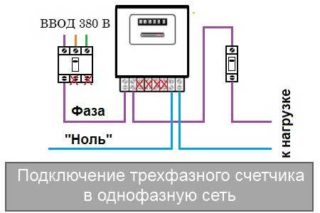 To connect a meter designed for three-phase power to a single-phase network, you first need to familiarize yourself with the differences between these two types of power supply. For each of them, the cable supplying voltage from the transformer substation has a zero working conductor N and phases (one or three).
To connect a meter designed for three-phase power to a single-phase network, you first need to familiarize yourself with the differences between these two types of power supply. For each of them, the cable supplying voltage from the transformer substation has a zero working conductor N and phases (one or three).
In a single-phase network, the voltage difference between the phase conductors A, B, C and zero is 220 volts, and between the phases themselves - 380 volts. The so-called "linear" voltage is formed due to the fact that the vectors of the acting potentials at each phase are shifted relative to each other by 120 degrees.
With the abundance in the sales market of various models of single-phase current meters, the inclusion of a three-phase meter in a single-phase network is extremely rare. In most cases, the circuit of such switching is similar to direct connection. The difference is that lines B and C are not connected to the meter, only one phase is to be connected. A significant drawback of this inclusion is the possibility of problems with regulatory organizations that really do not like all the options for exclusions that do not comply with current norms and standards.
New connection rules

You can connect electricity metering devices in private houses in various ways. The choice of a particular circuit for switching on a three-phase meter is determined by the capacity of the served loads, as well as the type of metering device itself. In the new edition of the PUE, number 7 specifically stipulates the installation and connection of three-phase and single-phase metering devices. The correct approach to solving this issue is to implement the following recommendations:
- 3-phase electricity meters should be connected according to the simplest and most reliable switching scheme;
- the current transformers used in this case must comply with the conversion factor provided for the selected meter sample;
- when connecting an electronic device, it is imperative that the loading of each phase of the supply line is uniform.
The last requirement assumes that the currents in each of the load circuits A, B and C should be approximately the same. Violation of this rule entails overloading the neutral conductor and its gradual destruction. Experts call this unpleasant phenomenon "burning off zero." It is dangerous in that when a zero break occurs, the combined neutral conductor loses its protective function. In such a situation, the danger of accidental high-voltage damage to an operator operating on electrical equipment increases sharply.
When considering ways of fixing the meter in the switchboard, the following approaches are distinguished:
- fixing by means of three fixing screws (this method is suitable for meter housings of type S or Ш);
- mounting the meter on a DIN rail specially equipped in the switchboard (for R or P enclosures).
In the second case, the position of the mounting rail is adjusted so that the holes on the device body and its own slots completely coincide.
Issues related to the connection of a three-phase electric meter in the shield of a private house are regulated by regulatory documents (PUE, for example). When organizing and conducting these procedures, the most important thing is to choose a reliable and safe option for incorporating the measuring device into the power line.
